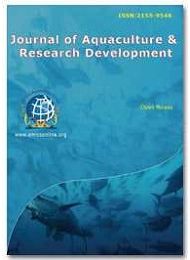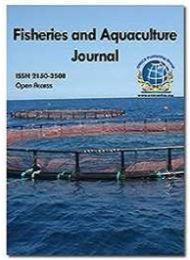Theme: Explore the sustainability and Innovation in Aquaculture and Fisheries
AQUACULTURE INSIGHT 2022
We welcome all the attendees to the 2nd International Conference on Aquaculture and Fisheries which will be held on November 07-08, 2022 at London, UK. Aquaculture Insight 2022 conference based on the theme “Explore the sustainability and Innovation in Aquaculture and Fisheries”. Aquaculture Insight 2022 provides an exceptional opportunity for the participants or delegates with their relative backgrounds to share their research ideas and to learn from other colleagues and co-partners about the modern scientific improvements and innovation in the field of Plants and its research. Our main objective is to empower the appealing research field along with the need for commercialization by giving a chance to come across the specialists and Business entrepreneurs in the field of Plant Science.
Aquaculture 2022 offers you a notable space opportunity to present and evaluate the latest update with a complete approach to different areas of attention. Aquaculture is Interdisciplinary research, reaching from Aquaculture to Marine Science and Fisheries to Oceanography.
Why Aquaculture Insight 2022?
Aquaculture is the platform to come across for interaction with participants from the Marine Biology associations, enthusiast leaders world’s top research scholars for interaction with participants from the Oceanography associations, Marine Science societies, Aquaculture, Fisheries, Animal Welfare, Shellfish Societies, Aquatic Studies and Aquaculture Academicians. It provides sharing and learning about the latest research on Aquatic research and other relevant to Aquatic and Fisheries sciences, as well as for launching new applications and technologies and the effectiveness of various regulatory programs on Marine Biology management towards Aquaculture Insight 2020 Conduct presentations, share knowledge, meet with current potential and eminent scientists, and receive name recognition at this two days event.
Our aim is to aggregate community and to create a platform for an exchange of information on technological developments, new scientific innovations and the effectiveness of various regulatory programs towards Aquaculture Insight 2020. It provides a premier technical forum for expressing and learning about the advanced research and developments, as well as for launching new applications, technologies and to explore new trends in the field of Marine science.
This conference will play a crucial role which allows the latest techniques and modern methodology in the field of Aquaculture and Fisheries and it covers all the major topics that come across like Aquaculture and Aqua Farming and its methods, Advancement in aquaculture, Importance in Aquaculture, Aquaculture Sustainability, Nutrition and Disease in Aquaculture, Fisheries and its Farming, Fisheries management, Sea food & Nutrition, New technologies in Fisheries, and Marine Ecology and Biological Oceanography, Aquaculture and Fisheries Resources, Livestock Production, etc. in different fields.
Our final agenda will focus on the scientific sessions, plenary lectures, panel discussion, meetings pertaining to recent advancements and emerging methodologies which make our event a grand success.
Target audiences:
· Directors and CEOs of research-based firms
· Manufacturing Aquaculture Device Companies.
· Marine researchers.
· Aqua culturist and Oceanographers
· R & D Companies.
· Marine and Ocean Associations societies.
· Aquaculture and Fisheries Sciences.
· Business entrepreneurs in Aquaculture and Fisheries Sciences.
· Climate change researchers.
· Nutritionist
· Research students and PhD’s.
· The technical employees.
· Professors and HOD’s
· Students of Fisheries sciences
· New entrepreneurs and their researches
· The Scientists associated with Aquaculture Insight 2022
· Academicians associated with Aquaculture Biology and Fisheries Science.
· Patent Attorneys
Track 1: Aquafarming
Aquafarming is the cultivating of fish, crustaceans, molluscs, aquatic plants, algae, and other aquatic organisms. It includes developing freshwater and saltwater populaces under controlled conditions, and can appear differently in relation to commercial fishing, which is the reaping of wild fish. On aquafarms, high-volume frameworks control nourishment, light on indoor homesteads, and development incitement. The Food and Agriculture Organization of the United Nations reports that the aquaculture business is growing three times quicker than terrestrial animal horticulture, and aquafarms will without a doubt turn out to be significantly more common as our regular fisheries wind up noticeably depleted.
Track 2: Pisciculture
Pisciculture or fish farming includes raising fish in tanks or walled in areas, mostly for sustenance. It is the most significant form of aquaculture, while different techniques may fall under mariculture. Around the world, the most critical fish species utilized as a part of fish farming are carp, tilapia, salmon, and catfish. Fish farms can appear as submerged mesh cages or as solid enclosures in areas ashore. Today, an enormous portion of the fish consumed globally is raised in these artificial environments.
Track 3: Aquaculture Nutrition
At the point when fishes are kept in aquaculture, it must be ensured that the fish get the supplements they require for development and proper health. Fish meal and fish oil have been the customary beginning stages for good fish feed, since they contain the supplements that fish require. It has turned out to be certain that plant proteins can supplement fish meal, since crude materials from the plant kingdom contain adequate measures of the critical amino acids, which are the building squares of proteins. Fish meal ought to contain significant measures of iodine, selenium and vitamin A.
Track 4: Aquatic & Marine Pathology
Like humans and other organisms, fish suffer from parasitic infestation and diseases. The defensive mechanisms can be specific and non-specific. Non-specific mechanisms consist of skin and scales, and additionally the mucus layer secreted by the epidermis that traps microorganisms and restrains their growth. On the off chance that pathogens break these defenses, fish can create inflammatory responses that enhance the flow of blood to infected territories and deliver WBCs that attempt to kill the pathogens. Specific defenses are specific reactions to specific pathogens perceived by the fish's body that are adaptive immune reactions.
Track 5: Fish hatchery
A fish hatchery is an area for artificial breeding, hatching and raising through the early life phases of animals, finfish and shellfish in particular. A few fish species that are usually brought up in hatcheries consists of Pacific oysters, shrimp, Indian prawns, salmon, tilapia and scallops. Hatcheries deliver larval and juvenile fish (and shellfish and crustaceans) principally to aid the aquaculture business where they are exchanged to on-growing systems i.e. fish farms to achieve reap estimate.
Track 6: Fish stocking
Fish stocking is the act of rearing fish in hatcheries and discharging them into a waterway, lake, or the sea to make new or supplement existing populaces of threatened or endangered fishes in a waterway shut to angling. Fish stocking can give many advantages, for example, making new fisheries or expanding existing ones and is perceived for its significance to the group regarding quality business, recreational, or tribal angling, conservation purposes, employment and ensuing monetary advantages that have developed in light of the action over numerous years. Protection and conservation of our unique biodiversity should be ensured while fish stocking.
Track 7: Shrimp farming
Shrimp farming is the practice of harvesting shrimp or prawns for human utilization. This can be carried out in marine or freshwater systems. It is an aquaculture business that started in the 1970s, and production developed steeply, especially to coordinate the market requests of the United States, Japan, and Western Europe. Shrimp cultivating has made considerable progress and has changed into a worldwide industry, from the little scale cultivates in Asia and Thailand. There are just a couple of types of shrimp that are cultivated internationally. A standout amongst the most well-known species is the Macrobrachium rosenbergii, the Giant Malaysian Prawn, which is a freshwater prawn, local of South Asia.
Track 8: Oyster farming
Another noted aquaculture practice is the oyster cultivation where oysters are reared mainly for human consumption. Oyster farming began as early as 1st century BC on the Italian peninsula by the ancient Romans and later developed in Britain too for the purpose of export to Rome. Aquacultured oysters were the main source of oysters for the French oyster industry since the late 18th century. Oysters normally develop in estuarine bodies of salty water. They generally reach market size within 18 months to 2 years
Track 9: Algaculture
Algaculture is the commercial harvesting of algae. It is a type of aquaculture. A major portion of the algae that are deliberately developed fall into the classification of microalgae, additionally alluded to as phytoplankton, microphysics, or planktonic green growth. Macroalgae, normally known as kelp, additionally have numerous uses, however because of their size and the particular environmental requirements in which they have to develop, they don't lend themselves as promptly to development on an extensive scale as microalgae and are frequently harvested wild from the sea.
Track 10: Mariculture
Mariculture alludes to the development of marine life forms in seawater, more often than not in protected coastal waters. The cultivation of marine fish is a case of mariculture, thus additionally is the cultivating of marine crustacean, e.g. shrimp, molluscs, e.g. oysters and kelp. Mariculture may comprise of raising the life forms on or in simulated walled in areas, for example, floating fenced areas for salmon and on racks for oysters. For the instance of enclosed salmon, they are fed by the operators and oysters on racks channel feed upon naturally accessible food.
Track 11: Integrated Multi-trophic Aquaculture
Integrated multi-trophic aquaculture (IMTA) includes developing fed species with extractive species that use the inorganic and organic wastes from aquaculture for their development. It consolidates, in the fitting extents, not only the cultivation of fed aquaculture species with organic extractive aquaculture species but also inorganic extractive aquaculture species to make adjusted frameworks for ecological maintainability, monetary dependability, and social acceptability.
Track 12: Issues in Aquaculture Netting Materials
Various materials, including nylon, polyester, polypropylene(PP), polyethylene(PE), polyamide(PA), plastic-coated welded wire, rubber, patented rope products, galvanized steel and copper are used for netting in aquaculture fish enclosures around the world. The material strength of net panels made with PA, PP and PE gets reduced when exposed to sunlight (UV), wind, rain, acid rain, etc. Materials being soft can also be damaged by crabs and fish with strong dentations resulting in fish escape from the cage. By inhibiting microbial growth, copper alloy aquaculture cages avoid biofouling costly net changes that are necessary with other materials.
Track 13: Fishing Technology
The strategies and the procedure utilized for catching the fishes for various purposes are termed as fishing technology. The term may likewise be applied to techniques for capturing other aquatic animals such as molluscs and edible marine invertebrates. Some of the fishing techniques comprises of hand gathering, spearfishing, netting, angling and trapping. The successful utilization of fishing techniques relies upon knowledge about the fish and their behavior including migration, rummaging and natural surroundings.
Track 14: Aquaculture Innovations & Designs
Seaward fish ranches are driving the charge with regards to cutting edge aquaculture innovation, procedure and outline. Advancements in research keep on leading to changes in aquaculture generation frameworks, bringing about expanded creation productivity, higher product quality for customers and a more sustainable industry.
Track 15: Recirculating Aquaculture Systems
Recirculating Aquaculture Systems (RAS) employ filtration of water from the fish (or shellfish) tanks so it can be reused inside the tank. This drastically decreases the amount of water and space required for intensive generation of seafood products. Solids removal, ammonia removal, Co2 removal and oxygenation are some of the steps that RAS incorporate. Recirculating aquaculture is developing at a decent time to meet market requests for seafood and to serve the changing needs of land-based cultivating operations.
Track 16: Aquaponics
Aquaponics is basically the blend of aquaculture and hydroponics in a symbiotic environment. The fish waste gives a natural sustenance source to the plants, and the plants actually filter the water for the fish. Ammonia from the fish waste is first converted into nitrites and then to nitrates by the nitrifying bacteria. Additionally, fish waste is converted into vermicompost that acts as a food for the plants.
Track 17: Aquaculture Resource Management
The effective and efficient utilization of the available resources pertaining to aquaculture is referred to as aquaculture resource management. It is required keeping in mind the end goal to decide the best maintainable yield of market-sized animals within a given time period. Such management is required to employ utilization of financial information and ecosystem services valuation philosophies alongside past researches.
Track 18: Aquaculture Engineering
Aquaculture engineering aims to provide solutions to technical problems related with harvesting of aquatic vertebrates, invertebrates, and algae. Design and development of the field not only requires knowledge of mechanical, biological and environmental systems but also of material engineering and instrumentation. Solutions from wastewater treatment, fisheries, and traditional agriculture additionally aid in engineering techniques.
Track 19: Aquatic Physiology
Aquatic physiology studies the morphology and function of the various parts of the organisms inhabiting the aquatic ecosystem. The effect of environmental stress conditions on the aquatic inhabitants can be studied with the help of structural and physiological information obtained from this field of study.
Track 20: Aquatic Plant farming
A method of cultivating aquatic plants in water comprises of aquatic plant farming. Such plants are fundamental to a healthy aquatic ecosystem. They can act as a source of sustenance for fishes and also provide oxygen. Floating aquatic plants shut out sunlight from reaching the rest of the water column which in turn limits the growth of other aquatic plants and can also regulate the amount of oxygen so that the fish can breathe.
Track 21: Marine Biology
The sub-discipline of biology concerned with the study of all life forms that inhabit oceans and freshwater of the earth is known as marine and aquatic biology. Life forms possess morphological and anatomical adaptations that empower them to live and flourish in aquatic habitats. Scientific investigations inherent to this field often analyze the human impact on and interaction with aquatic systems and range from the molecular level of contaminants to the stresses on entire ecosystems.
Track 22: Socioeconomics of Fisheries & Aquaculture
One of the fastest developing food-producing sectors is Aquaculture, and as of now contributes about 40% of the world supply of fish and other aquatic organisms. The advantages of the development are no doubt genuine and unmistakable for both producing countries and for consumers in the form of lower prices. Ideally it is likely to be able to attach a monetary value to the ecological effects of aquaculture, and in a few occurrences this is conceivable where a quantifiable impact on creation can be distinguished.
Track 23: Sustainability in Aquaculture Practice
Growing concern over the environmental impact of aquaculture, in any case, has incited an analysis for an administration structure that can ensure supportability – that is, a fiscally reasonable aquaculture industry in which the ecological harm is limited. Sustainable aquaculture is a dynamic idea and the supportability of an aquaculture framework will fluctuate with species, area, societal standards and the state of information and innovation.
Track 24: Captive Fishing
Captive fishing, also known as wild fishing is exploitation of aquatic organisms without stocking the seed. This often exists in the sea, rivers, reservoirs, continental shelves, around coasts, etc. Fish yield decreases gradually in capture fisheries due to indiscriminate catching of fish including brooders and juveniles. Captive Fishing and their subsequent re-introduction of an endangered species is an essential and in some instances a quite successful method for conservation of such species.
Track 25: Aquaculture laws & regulations
Developing and implementing policies that enable marine aquaculture and works to ensure that aquaculture complies with existing federal laws and regulations are a very essential step in the field of aquaculture. Such policies and regulations ensure environmental protection, water quality, food safety, increase efficiency, transparency, and predictability in making permit decisions and protection of public health.
Track 26: Fisheries Ecology & Management
Fisheries ecology and management employs mechanisms that regulate fish populations, food webs, and community structure and dynamics. Pollution and global warming have been the predominant causes of unprecedentedly low fish stocks in recent years. Fish communities can be altered in a number of ways which affects predator and prey dynamics.
Track 27: Biotechnology & Genetics in Aquaculture, Fisheries
For the purpose of sustainable development of aquaculture and fisheries, biotechnology proves to be a very effective tool. The combination of genetic alteration and biotechnology to expand the production of aquatic species, embraces incredible potential to take care of demand as well as to ameliorate aquaculture. Researchers are exploring genes that might enhance the generation of natural fish growth factors and additionally, the natural defense compounds marine living beings utilize to battle microbial contaminations.
Aquaculture Insight 2022 welcomes all the attendees, presenters, associations and exhibitors from all over the world to London, UK. We are delighted to invite you all to attend the “2nd International Conference on Aquaculture and Fisheries” which is going to be held on November 07-08 London, UK. The congressional committee is gearing up for an exciting and informative conference program including keynote presentations, plenary lectures, young research forum, symposia, and workshops on informative topics, poster presentations and various program for participants from all over the world. We heartily invite participants from all over the globe to take part in Aquaculture Insight 2022, to share meaningful experience from scholars around the world. We look forward to seeing you in London.
Importance and Scope:
Aquaculture Insight 2022 with the theme “Explore the Sustainability and Innovation in Aquaculture and Fisheries” aims to share new ideas and new technologies and to optimize and enhance existing systems and it has the latest marine research for liquid transportation. As per reports by the international energy, agency indicates that global advanced aquaculture research operating capacity will double from 2 billion litres to 4 billion litres during 2013 to 2022, while global Fisheries researchers would grow from 115 to 139 billion over the same period. New reports suggest that advanced Aquaculture and Fisheries techniques now account for over half of newly installed Aquaculture and Fisheries Technology.
Why London?
London, the capital of England and the United Kingdom, is a 21st-century city with history stretching back to Roman times. Standing on the River Thames, London has been a major settlement for two millennia, its history going back to its founding by the Romans, who named it Londinium. London's ancient core, the City of London, largely retains its 2.9 km2 mediaeval boundaries and in 2011 had a resident population of 7,375; making it the smallest city in England. Since at least the 19th century, the term London has also referred to the metropolis developed around this core. The bulk of this conurbation forms the Greater London administrative area, governed by the Mayor of London and the London Assembly. London is a leading global city, with strengths in the arts, commerce, education, entertainment, fashion, finance, healthcare, media, professional services, research and development, tourism, and transport. It is one of the world's leading financial centres. London is a world cultural capital. London's 43 universities form the largest concentration of higher education institutes in Europe. In 2012, London became the first city to host the modern Summer Olympic Games three times. London has a diverse range of peoples and cultures, and more than 300 languages are spoken within Greater London. The region had an official population of 8,416,535 in 2013, the largest of any municipality in the European Union, and accounting for 12.5% of the UK population. London contains four World Heritage Sites: The Tower of London; Kew Gardens; the site comprising the Palace of Westminster, Westminster Abbey, and St Margaret's Church; and the historic settlement of Greenwich (in which the Royal Observatory, Greenwich marks the Prime Meridian, 0° longitude, and GMT). Other famous landmarks include Buckingham Palace, the London Eye, Piccadilly Circus, St Paul's Cathedral, Tower Bridge, Trafalgar Square, and The Shard. London is home to numerous museums, galleries, libraries, sporting events and other cultural institutions, including the British Museum, National Gallery, Tate Modern, British Library and 40 West End theatres. The London Underground is the oldest underground railway network in the world.
Conference Highlights:
Aquaculture & Aqua Cultivation
Types of Aquaculture & Methods
Nutrition & Diseases in Aquaculture
Marine environment and Biological Oceanography
Aquaculture & Fisheries Resources
Why Attend?
Aquaculture and Fisheries 2022 is a platform to meet your target market with individuals from around the globe concentrated on finding out about advertising and showcasing, and insightful leaders through the research talks and presentations and encourage many novel approaches of production and scale-up of Aquaculture Research. It adds a forum for all stakeholders, immense industrialists in the Oceanography and Marine Research sector, original research, featuring review articles, research and development spotlights, news, commentaries, interviews with keynote speakers and much more, with a prospect to building an international community of Aquaculture and Fisheries communication.
Members association with Plant Science
The target audience will be Aquaculture and Fisheries associations, Marine physiologists, Marine plant researchers, Aquatic Plant biotechnologists, Aquaculture genomics students and scientist, Fisheries genomics scientists and faculty, business entrepreneurs, and the manufacturing companies of Aquaculture-related products.
Major Plant Aquaculture Associations around the Globe
Global Fisheries and Aquaculture Universities:
Shanghai Fisheries University, China
National Fisheries University, Japan
Agricultural University of Norway, Norway
Chulalongkorn University, Thailand
Deakin University, Victoria
Linders University, Australia
Ocean University, China
Nagasaki University, Japan
Hokkaido University, Japan
Heriot-Watt University, United Kingdom
James Cook University, Australia
Malaspina University-College, Canada
Northern Territory University, Australia
Rhodes University, South Africa
State University of Ghent, Belgium
Shanghai Ocean University, China
Kyoto University, Japan
Ehime University, Japan
Memorial University, Canada
Auburn universities, US
Brunswick Community College, United States
Delaware State University, United States
Hofstra University, United States
Humboldt State University, United States
Global Fisheries and Aquaculture Research Institutes
Andalusia Centre for Marine Science and Technology, Spain
Bureau of Fisheries and Aquatic Resources, Philippine
Central Institute of Brackish Water Aquaculture, India
Central Institute of Fisheries Technology, India
Central Marine Fisheries Research Institute, India
Deep Bay Marine Field Station, Canada
Fisheries Research and Development Corporation, Australia
Fisheries Research Services Marine Laboratory, UK
Global Ocean Ecosystem Dynamics, Chile
Korea Institute of Maritime and Fisheries Technology, South Korea
National Fisheries Research & Development Institute, South Korea
Marine Institute Ireland, Ireland
Global Fisheries & Aquaculture Societies:
Asian Fisheries Society
China Society of Fisheries, China
Korean Society of Fisheries and Sciences (KOSFAS), Korea
Aquaculture Association of Canada, Canada
Aquaculture Association of S. Africa, South Africa
European Aquaculture Society, Europe
Brazilian Aquaculture Society (AQUABIO), Brazil
Indonesian Aquaculture Society, Indonesia
Society of Aquaculture Professionals, India
Malaysian Fisheries Society, Malaysia
Egyptian Aquaculture Society, Egypt
Spanish Aquaculture Association (SEA), Spain
Funding Agencies:
Food and Agriculture Organization of the United Nations, USA
Taiwan Fish Society, Taiwan
Malaysian Fisheries Society, Malaysia
National Oceanic and Atmospheric Administration
A Unique Opportunity for Advertisers and Sponsors at this International event:
The European Aquaculture and Fisheries report determines the concerned market in Europe on the basis of analysis and forecast of revenue. Europe is the second-largest market of Marine Science. The value of Plant Aquaculture market in Europe was $1078.9 million in 2013 and is estimated to grow to $1494.2 million by 2022, at a Compound Annual Growth Rate (CAGR) of 9.6% from 2013 to 2022. Germany has the largest share in the European marine an oceanography studies and is expected to grow at a CAGR of 7.7% from 2013 to 2022, followed by France, which is expected to grow at the same CAGR as that of Germany. Europe is the second-largest market poised to reach $296.56 million by 2022 and is estimated to grow at a CAGR of 6.3% from 2013 to 2023.
The European Aquaculture research market mainly focuses on Aquaculture techniques and Shellfish Farming, Marine science techniques and rise in venture capital funding and investments. Germany accounted for the highest share of the European Aquaculture research market in 2013 and expected to grow at a CAGR of 8.4%, during the forecast period of 2013 to 2022. Genetically Modified Organization based diagnostics dominated the overall market in terms of revenue at 42.4% in 2013 majorly owing to the presence of a relatively larger number of research and development programs. Plant genetically engineered plant segment, on the other hand, is expected to grow at the fastest CAGR of over 16.0% from 2014 to 2022 due to increasing demand for population-based therapeutic solutions and subsequent increase in R&D initiatives.
Market value on Aquaculture:
The hugeness of plants in human life is noteworthy. Plants and plant items are fundamental for us. Sustenance, vitality, solution thus numerous things we can get from plants. This meeting looks to bring all such researcher, Noble Laureate, scientist, examine researcher, understudies and individuals together who are engaged with this field and give them to talk about their development, trade thoughts and connection with each other.
Meet your target market
The peoples from around the globe are focusing on learning the overview and techniques of Aquaculture and Fisheries. So here is the opportunity to reach the largest group of a participant from around the world for grasping the knowledge of different field on a single platform. The conference will conduct Keynote presentations, Oral talks (Speaker forum and Young research forum), Poster presentations, Workshops and Exhibitions and receive a participation certificate at the 2 days event.
PRESENTATION REQUIREMENTS:
- Presenting authors are responsible for registration, travel, and hotel costs. Note: Those with accepted abstracts will receive an acceptance mail allowing them to register for the conference.
- Abstracts will be compiled and conference books are made available to participants at the conference.
- Any presenter who is unable to attend should arrange for another qualified individual to present the paper/poster in question. If such a change is necessary, please notify our conference team
SUBMISSION OPTIONS:
- Oral paper presentations will have 30-minute time slots and be clustered by theme into sessions. The keynote session will have for a 45-minute time slot, workshop/ special session will have a 60-minute time slot and symposium will have 60-minute time slot followed by 5-minute Q&A session.
- Graduate & Masters students are eligible to submit their abstracts under poster and e-poster presentation category.
- PhD students are eligible to submit their abstract under special YRF (young researcher’s forum), poster and e-poster presentation category.
NOTE: YRF category includes short oral presentation especially for Ph. D. students
- Extended abstract: Submissions should utilize the Abstract Template. Papers submitted in this category may represent original empirical research, theoretical development, reviews, or critiques.
Conference Highlights
- Aquafarming
- Pisciculture
- Aquaculture Nutrition
- Aquatic & Marine Pathology
- Fish hatchery
- Fish stocking
- Shrimp farming
- Oyster farming
- Algaculture
- Mariculture
- Integrated Multi-trophic Aquaculture
- Issues in Aquaculture Netting Materials
- Fishing Technology
- Aquaculture Innovations & Designs
- Recirculating Aquaculture Systems
- Aquaponics
- Aquaculture Resource Management
- Aquaculture Engineering
- Aquatic Physiology
- Aquatic Plant farming
- Marine Biology
- Socioeconomics of Fisheries & Aquaculture
- Sustainability in Aquaculture Practice
- Captive Fishing
- Aquaculture laws & regulations
- Fisheries Ecology & Management
- Biotechnology & Genetics in Aquaculture, Fisheries
- Fisheries Science
- Aquatic Pollution
To share your views and research, please click here to register for the Conference.
To Collaborate Scientific Professionals around the World
| Conference Date | November 07-08, 2022 | ||
| Sponsors & Exhibitors |
|
||
| Speaker Opportunity Closed | |||
| Poster Opportunity Closed | Click Here to View | ||











